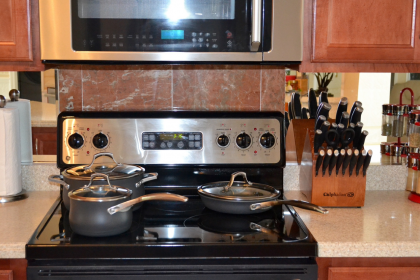Imagine stepping into your living room and feeling like you’re in a state-of-the-art cinema. Today, creating a home cinema experience is easier and more affordable than ever. With the right audio-visual equipment, you can enjoy your favorite movies, shows, and sports with the same immersive quality of a theater—all within the comfort of your home. Here, we’ll look at the essential components you need and guide you through choosing the best options for your budget and space.
Setting Up Your Home Cinema: Essential Equipment
Turning your living room or spare room into a home theater requires more than just a big screen. Here’s a breakdown of the key elements to make your movie nights truly memorable.
1. The Right Screen: Choosing Between TV and Projector
The first question for any home theater setup is whether to use a large TV or a projector. Both have their pros and cons:
Large TVs: A high-definition TV, especially an LED or OLED model, offers incredible picture clarity, vivid colors, and longevity. LED TVs are great for brighter rooms, as they reduce glare, while OLED TVs provide excellent contrast and black levels, making them perfect for dark rooms.
Projectors: For the true cinematic experience, a projector paired with a high-quality screen offers the largest screen size. Modern projectors are now more affordable and provide stunning picture quality, especially when used in low-light rooms. Look for models with 4K resolution for a sharp image, even on a large screen.
Choosing between a TV and a projector depends on your room size, light control, and budget. If you love the traditional cinema feel and have a dedicated space, a projector may be ideal. For a smaller, more versatile setup, a large TV might be your best bet.
2. Audio System: Surround Sound for Immersive Audio
Sound quality is a huge part of the cinema experience. A quality audio setup makes all the difference, transporting you into the world of the film.
Soundbars: If you’re short on space or budget, a soundbar is an easy way to enhance audio without a complex setup. Many soundbars come with a wireless subwoofer for richer bass.
Surround Sound System: For a more immersive experience, consider a 5.1 or 7.1 surround sound system. A 5.1 setup includes five speakers and one subwoofer, while a 7.1 adds two extra speakers for even greater depth. These setups bring sounds from different directions, making you feel like you’re inside the action.
Dolby Atmos: If you’re after a true high-end audio experience, Dolby Atmos speakers add height channels, creating a 3D effect. Many modern soundbars also support Dolby Atmos, giving you a theater-like audio experience without multiple speakers.
When choosing an audio system, consider your room’s acoustics and size. Larger rooms benefit from multiple speakers, while smaller spaces can achieve great sound with a compact soundbar or 5.1 system.
3. Blu-ray Player vs. Streaming Device: Accessing Your Content
Streaming has revolutionized how we access movies and shows. However, if you’re a purist about picture quality, a Blu-ray player might be worth considering. Blu-ray discs offer higher-quality images and audio compared to streaming, especially for 4K content. If you prefer the convenience of streaming, a smart TV or a streaming device like Fire Stick, Chromecast, or Apple TV lets you access platforms like Netflix, Amazon Prime, and Disney+ effortlessly.
Many streaming devices now support 4K and HDR, offering impressive image quality with minimal setup. For serious cinephiles, consider both a Blu-ray player and a streaming device to get the best of both worlds.
4. Comfortable Seating: More Than Just a Couch
No theater experience is complete without comfortable seating. Investing in a few key pieces can make movie marathons more enjoyable:
Recliners: Plush, adjustable recliners add a luxury feel to your setup. Many models also have cup holders and USB ports for charging devices.
Sectional Sofas: If you want to create a space for the whole family, a sectional sofa offers ample seating and can be easily adjusted to suit different layouts.
You can also add soft blankets and pillows to make the space cozy. When you’re comfortable, you’re more likely to fully enjoy the immersive experience.
Enhancing the Cinema Experience: Additional Tips
1. Lighting Control for Better Viewing
Lighting plays a crucial role in enhancing image quality. To reduce glare and improve contrast, consider using blackout curtains or blinds. Some people also install dimmable LED lights around the screen area to create a subtle glow, which can enhance the visual impact without causing eye strain.
2. Acoustic Treatment: Reducing Sound Distortion
To improve audio quality, use carpets or rugs to reduce echo. Wall-mounted acoustic panels or heavy curtains can also help minimize sound distortion. These additions keep the audio crisp and clear, creating a professional cinema-like feel.
3. Smart Home Integration for Seamless Control
For ultimate convenience, consider integrating smart home technology. Devices like Google Home, Amazon Alexa, or a universal remote allow you to control lights, sound, and screen settings with voice commands. With a simple command, you can dim the lights, lower the screen, and start the movie.
Budget-Friendly Tips for a Home Theater Setup
Creating a home cinema experience doesn’t need to break the bank. Here are some budget-friendly ideas to achieve great results:
DIY Projector Screen: Instead of buying a professional screen, use a smooth, white wall or a high-quality projector screen fabric for similar results.
Second-hand Equipment: Look for gently used sound systems or projectors online. Many people upgrade regularly, so you can often find excellent equipment at a fraction of the retail price.
Start Small and Upgrade: Begin with a quality TV and soundbar, then add surround sound speakers and other components as your budget allows. Building your system gradually gives you time to find the best deals.
Setting Up Your Home Theater: A Step-by-Step Guide
Choose the Room: Ideally, pick a room with minimal outside light and sound. Basements or spare rooms are often best.
Plan Your Layout: Arrange seating, screen, and speakers for optimal viewing and sound quality. Place speakers at ear level when seated for the best experience.
Set Up Audio and Visual: Mount your TV or projector screen, set up your speakers, and calibrate the audio settings. Proper calibration ensures sound is clear and balanced throughout the room.
Test the Lighting: Adjust the room’s lighting to reduce glare. Experiment with dimmable lights or install blackout curtains if needed.
Add Comfort: Finalize seating and add any other comforts, such as throw blankets, pillows, and small tables for snacks.
Final Touches to Enhance the Home Cinema Vibe
You’ve assembled the hardware, but a few thoughtful details can make the room feel even more like a personal cinema. Consider adding:
Movie Posters or Décor: Frame posters of your favorite movies or add cinema-style lighting to give the room a fun, themed atmosphere.
Snacks Station: A small table or trolley with popcorn, drinks, and snacks can make movie nights extra special.
Storage for Remotes and Gadgets: Keep remotes, headphones, and chargers organized to avoid the last-minute scramble.
Enjoy Your Home Cinema Experience
Setting up a home cinema is an exciting project that transforms your home into an entertainment hub. By choosing the right audio-visual equipment, focusing on comfort, and considering the finer details, you’ll create a space that brings family and friends together for unforgettable movie nights. Ready to start building your home theater? Get started with just a few essential items and make every movie night a special occasion.
Got any tips on creating the perfect home cinema? Share your ideas and favorite setups in the comments below!





